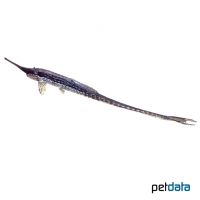Twig Catfish (Farlowella platorynchus)
| Twig Catfish Farlowella platorynchus | |
|---|---|
| Name | Twig Catfish |
| Name Lat. | Farlowella platorynchus |
| Family | Suckermouth Armoured Catfishes |
| Family lat. | Loricariidae |
| Order | Catfishes |
| Order lat. | Siluriformes |
| Origin | Peru, Bolivia |
| Habitat | Tributaries |
| Diet | Omnivore |
| pH | 6.0-7.0 |
| Behavior | Nocturnal, peaceful |
| Keeping | Group |
| Care Level | Moderate |
| Reproduction | Substrate spawner |
| Breeding | None reported |
| Life Span | 5-10 years |
| Protection | No |
| Metric Units | |
| Size | 15-20 cm |
| Temperature | 24-27 °C |
| Hardness | 1-10 °dH |
| Aquarium | ~ 250 l |
| US Units | |
| Size | 6"-8" |
| Temperature | 75-81 °F |
| Hardness | 18-178 ppm |
| Aquarium | ~ 65 gal |
Distribution and habitat
Longnose needle catfish are common in the Río Ucayali watershed in the upper Amazon basin of Peru. They live in stagnant or slow-flowing waters, often on sandy bottoms among fallen leaves, branches and roots protruding into the water.
Maintenance
The aquarium should have a dense border planting with broad-leaved species, roots, round stones and hiding places (caves, clay tubes) as well as free sandy areas of fine-grained sand covered with some foliage (oak, sea almond tree). Subdued light (floating plant cover) and a weak current is ideal.
Ammonia, ammonium and nitrite must not be detectable in the water, and the nitrate value must not exceed 100 mg/l. To ensure water quality and oxygen content, a filter and heater adapted to the aquarium size is required, as well as lighting for the species-appropriate day-night rhythm of the animals.
Diet
They feed on plant and animal food. For a balanced diet, feed once a day with a high-quality dry food for loricariid catfish (granules, pellets, chips, tablets), supplemented with algae leaves and fresh vegetables, such as zucchini, broccoli, bruised peas, scalded spinach, as well as zoopankton, cyclops, daphnia, artemia, mosquito larvae, shrimp, etc. (live or frozen). Feed only as much as will be eaten within a few minutes, excluding plant foods. Regular and varied feeding promotes health and increases resistance.
Behaviour and compatibility
These crepuscular to nocturnal fish are peaceful within the species and towards other fish. At least 5 animals should be kept together. They should only be socialized with very calm and peaceful fish. Keeping them together with burrowing catfish like Corydoras is not recommended
Basically, only compatible fish species with similar demands on water quality and water temperature should be socialized.
Sex dimorphism
Sexually mature males have a broader head than females and a larger, proboscis-like extension of the tip of the snout (rostrum), which is covered with a few bristles (odontodes) during spawning.
Reproduction and breeding
There are no known reports of successful breeding in the aquarium. Presumably, like other needle catfishes, they are substrate spawners. The females attach their eggs in an elongated cluster to a substrate (leaves, roots, aquarium glass).
Important
Among the needle catfishes, the longnose needle catfishes have the longest and widest rostrum.
When catching, use nets with as fine a mesh as possible so that the hard rays of the pectoral fins or the skin teeth (odontodes) do not get caught on the bone plates, which can cause painful puncture wounds when touched.
The well-being of the fish should be checked regularly. Temperature should be checked daily, pH, hardness and nitrate levels at least every 14 days. Regular partial water changes are recommended, even when contaminant levels have not yet reached the upper limit. Sudden changes in water quality should be avoided. Newly introduced fish must be accustomed slowly to the water in the aquarium
Further literature can be found in your pet store.
References
Text: Werner Winter; Image: petdata
Source: BMELV (1998): Tierschutzgutachten - Haltung von Zierfischen (Süßwasser); ENGELMANN (2005): Zootierhaltung - Tiere in menschlicher Obhut: Fische, Verlag Harri Deutsch
- Gemäß § 21 Abs. 5 Tierschutzgesetz idgF
